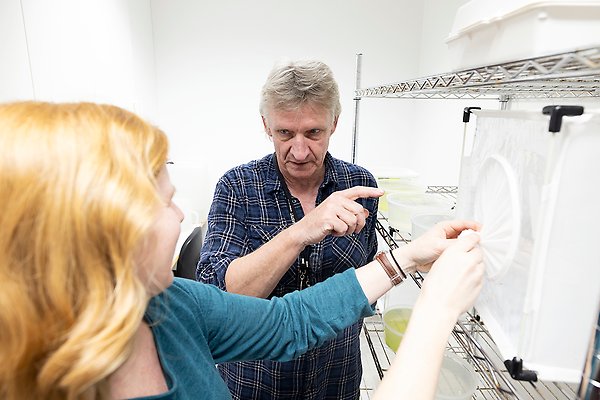Warming could lead to new diseases in Sweden

The Zoonosis Science Center has a BSL-3 laboratory where researchers can study serious viruses in safe conditions. Photo: Mikael Wallerstedt.
As the climate warms, mosquito species not previously present here and which can carry serious pathogens are able to establish themselves in Sweden. As well as new species of ticks. Åke Lundkvist, professor at the Zoonosis Science Center at Uppsala University has studied zoonoses, i.e. infectious diseases that spread from animals to humans, for over 30 years.
One of the zoonoses approaching Sweden’s borders is West Nile fever. It causes high fever, headache, and muscular pain, and in the worst case inflammation of the brain. Older people in particular are at risk of serious illness and death from this disease.
“It’s probably the zoonosis that is causing the most concern in Europe. And we have now had cases as far up as in northern Germany,” says Åke Lundkvist.
Since we already have mosquito species and birds that can carry the virus in Sweden, it is seen as only a matter of time before we get the first cases of this disease acquired here.
Laboratory with a very high protection level
To conduct research on West Nile fever and other serious infectious pathogens that spread from animal to human, the researchers at the Zoonosis Science Center have access to a laboratory with a very high protection level – a BSL-3 (biosafety level 3) laboratory. There, they can investigate how the transmission routes and biological mechanisms work when influenza virus spreads from wild birds to domestic birds and then to humans, for example, without the risk of serious contagions entering the community.
In order to engage with the issue from as many angles as possible, researchers work together in the fields of virology, bacteriology, insect science, ecology, human medicine, veterinary medicine and bioinformatics.
One of the zoonoses that scientists believe should be watched carefully is dengue fever, which is transmitted from person to person via mosquitoes. At worst, it can be deadly. This disease is spreading throughout the world.
“We’ve known this for a long time. It was maybe just over 20 years ago that dengue fever became established in large parts of northern Australia. Now we are seeing cases in southern Europe too,” Lundkvist explains.

Researchers Åke Lundkvist and Jenny Hesson in the mosquito lab at the Zoonosis Science Center. The mosquito species kept there can carry serious diseases. Photo: Mikael Wallerstedt.
In Sweden, so far we do not have any of the mosquitoes that can carry this virus. But climate change has led to a climate where they could survive here during warmer summers. They usually travel to new areas as stowaways.
“For example, these mosquitoes lay eggs in old car tyres. The tyres almost always collect water if they are lying around outdoors. And then the tyres are shipped between different continents. We also travel a lot and people who have been infected abroad can bring the virus home, where it can spread if the right mosquito species exist locally,” says Åke Lundkvist.
Three times as many TBE cases
Due to climate change, changes in the distribution of zoonoses already established in Sweden are also being seen. One example is the Tick-borne encephalitis virus (TBEV), which is infecting more and more people. TBE occurs in southern and central Sweden, but the ticks that spread the virus are spreading further north.
“Although we have probably tripled our vaccination rate over the past ten years from approximately 600,000 doses sold per year to 1.8 million doses, during the same period the number of TBE cases that end up in hospital and are registered has also increased threefold. From about 200 to 600 last year, which was a record year,” Lundkvist says.
Just like with mosquitoes, researchers have seen that new species of ticks are entering Sweden. The Taiga tick, which can carry more severe forms of TBEV, has migrated from the east and established itself in northern Sweden.
Vole fever in Scania
Another of the many diseases they are tracking is vole fever (in Swedish, sorkfeber). It is caused by a virus found in bank voles. People are mainly infected when they inhale virus-contaminated dust from dried urine and faeces of voles which can be found in wood sheds, for example. The vole is common all over the country, but it is only north of Uppsala that people have been infected with vole fever – until now.
Recently, cases have also been found in the province of Scania in the south of Sweden. So far, there are few cases and Åke Lundkvist believes that the virus was introduced into voles in Scania relatively recently. But it is not voles from the north that have brought the virus there, as he and his colleagues have recently been able to show in a study.
“When we looked at the entire genome of the virus, we could see that it is not closely related to the virus we have in northern Sweden, but rather related to the virus that exists in Finland and Karelia,” Lundkvist explains.
Åsa Malmberg
Zoonoses mentioned in this article
Dengue fever
Mode of transmission: Between people via mosquitoes
Symptoms: Fever, nausea and vomiting, rash, generalised pain (myalgia), low white blood cell count. Severe dengue fever: severe bleeding, severe loss of body functions, or severe blood plasma leakage.
Transmission in Sweden: No
Vaccine: Yes
West Nile fever
Mode of transmission: From birds via mosquitoes
Symptoms: Illness with flu-like symptoms such as fever, headache and muscular pain, nausea and vomiting. Occasionally rashes and swollen lymph nodes. Just under one per cent of those infected become seriously ill with encephalitis or meningitis. In this group, the mortality rate is about 17 per cent.
Transmission in Sweden: No
Vaccine: Only for horses
Tick-borne encephalitis (TBE)
Mode of transmission: Via ticks
Symptoms: Headache, fatigue, muscular pain, and fever. In about one third of those infected, the disease spreads to the brain and cerebral membranes.
Transmission in Sweden: Yes
Vaccine: Yes
Vole fever
Mode of transmission: Via bank voles
Symptoms: High fever, muscular pain, headache, severe stomach and back pain. The disease can lead to acute kidney failure.
Transmission in Sweden: Yes
Vaccine: No
